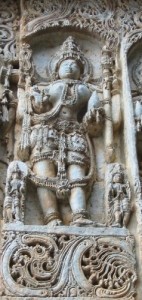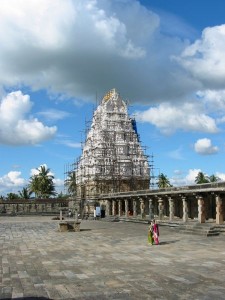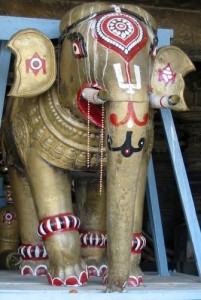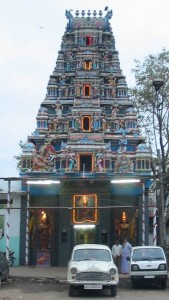 Wie schon gesagt, Indien hat noch eine Menge anderer Religionen und viele von ihnen haben auch interessante Werke hervorgebracht. Die Aufzählung hier ist aber bei weitem nicht vollständig…
Wie schon gesagt, Indien hat noch eine Menge anderer Religionen und viele von ihnen haben auch interessante Werke hervorgebracht. Die Aufzählung hier ist aber bei weitem nicht vollständig…
Wovon ich trotz Religionsabitur noch nie was gehört hatte war Jainismus… ich war nur in Sravanabelgola etwas verwirrt, warum die lauter Götter haben, von denen ich noch nie was gehört hatte und warum die alle irgendwas mit “tirthankar” im Namen haben.
Naja, kein Wunder, die Bahubali-Statue und auch die Tempel und Stelen drumherum sind nicht Hindu… sondern Jain. Die Statue auf dem Bild ist ein Monolith, also aus EINEM Felsblock gehauen. Man beachte die Menschen im Vordergrund, die Statue ist so groß.
Dargestellt wird Bahubali, der so lange meditierte, bis die Pflanzen über ihn wucherten. Und das Erreichen einer totalen Bedürfnislosigkeit ist, so sagte man mir, das erstrebenswerte Ziel des Jainismus. Bedürfnislosigkeit bezieht sich übrigens auch auf so Dinge wie “Kleidung” und wird offensichtlich auch praktiziert, wir haben auf dem Gelände einen “heiligen Mann” (oder wie auch immer die Jain das dann nennen) gesehen. (Wie das Problem mit dem Essen gelöst wird, da konnte mir keiner Auskunft geben… :o) )
As I said… there are quite some other religions in India. What I’n going to tell here is far from beeing complete…
I have done my “Abitur” in religious education (as one subject, not the only…), but I had never heard of Jainism. I just was a bit confused why in Sravanabelgola there were only “gods” I had never heard of and why they all had a “tirthankar” in their name…
Well the place is not hindu, so it’s not so surprising they have no hindu gods. It’s a Jain temple. The huge statue is a monolith, its made from one huge stone. And yes, it is as big as the figures in the foreground make it look.
The guy is Bahubali who did a very long meditations until plants grew over him. What a Jain wants to reach is having no needs at all. Including “clothes”. Any clothes. Well, the religion is still in practice, we saw a man who must be kind of “saint” or “monk” or whatever a Jain what call that. (What they do as far as food is concerned I couldn’t find out…)
 Synagoge haben wir nur eine gesehen, in Fort Cochin.
Synagoge haben wir nur eine gesehen, in Fort Cochin.
Aber immerhin…
Leider war diese geschlossen (nein, es war Freitag, nicht Samstag), so daß wir sie nur von außen sehen konnten.
Schade, irgendwie, zumal die Synagoge sehr alt ist, 1568 das erste Mal errichtet.
Was ich interessant finde ist, daß der Turm den man aus der Ferne sehen kann sehr an eine Kirche erinnert, auch gerade wegen der Uhr.
What we had not expected to find at all is a synagogue.
But there was one in Fort Cochin.
It’s a pity it was closed (even though it was not Saturday, but Friday), so we couldn’t see the inside.
The guide says it’s very old, build in 1568 (for the first time…).
What is interesting to me is the fact, that this tower looks quite like a church-tower, especially with the clocks on it.
 Was wir hingegen relativ oft gesehen haben waren christliche Kirchen.
Was wir hingegen relativ oft gesehen haben waren christliche Kirchen.
Zwar hatte ich schon gelesen, daß es gerade in Kerala relativ viele Christen gibt, aber auch in anderen indischen Staaten haben wir Kirchen gesehen.
(Die auf dem Bild steht an einem Fluß in Kerala und hat mich durch ihre fröhlich-bunte Farbgebung beeindruckt. Und durch die Elefanten…)
Daß man auch vor Betreten einer Kirche die Schuhe ausziehen muß war für uns hingegen sehr ungewohnt…
Christian churches we have seen quite a lot.
I had read before, that in Kerala are quite a lot of christians, but we’ve seen churches nearly everywhere in India.
(The picture was taken in Kerala and what I liked about that church were the strong and bright colours. And the elephants, of course…)
Taking of the shoes before entering a church on the other side was quite uncommon to us…
 Sehr schöne Beispiele islamischer Kunst gibt es ebenfalls zu sehen.
Sehr schöne Beispiele islamischer Kunst gibt es ebenfalls zu sehen.
Neben Moscheen haben islamische Herrscher auch sehr eindrucksvolle Bauwerke hinterlassen. Da diese eher im Norden Indiens lebten ist es keine Wunder, daß meine beiden Beispiele aus Delhi stammen.
In beiden Fällen handelt es sich um Grabmäler, die in parkähnliche Gärten eingebettet sind. Diese laden auch zum Spaziergehen und verweilen ein.
India offers also impressive examples of islamic art.
There are all kind of mosques, of course, but islamic rulers left also other interesting buildings. As the Moguls ruled in the north of India, my pictures were taken in Delhi.
In both cases it’s tombs that lay in the middle of park-like gardens and are quiet and peacful places for a stroll or to relax.
Das erste Bild zeig Humayum’s Tomb, wie der Name vermuten lässt das Grabmal von Humayum, das seine Witwe (oder eine seiner Witwen, wenn ich das richtig verstanden habe…) im 16. Jahrhundert errichten ließ.
Wer sich an Bilder vom berühmten Taj Mahal erinnert fühlt liegt nicht falsch, denn dieses Grabmal ist eines der “Vorläufer” des großen Werkes in Agra. (Welches wir diesmal nicht besichtigt haben.)
The first picture shows Humayum’s Tomb. From the name it’s easy to guess that it’s the tomb for Mogul Humayum. It was his widow (or one of his widows, if I got that right…) who had this build for her deceased husband.
If this reminds you the famous Taj Mahal you’re not wrong. It’s consicered to be one of the “predecessors” of the big building in Agra. (Which we haven’t visited this time.)
 Das letzte Bild zeigt Safdarjang’s Tomb.
Das letzte Bild zeigt Safdarjang’s Tomb.
Auch hier wieder ein stimmungsvoller Park außenherum.
Dieses Grabmal stammt aus dem 18. Jahrhundert und ist eines der letzten Beispiele der Mogul-Architektur.
Auch hier gibt der Name klar an, das es zu Ehren von Safdarjang errichtet wurde, in diesem Fall von seinem Sohn.
The last picture shows Safdarjung’s Tomb.
Again it’s surrounded by a very beautifull park.
This tomb was built in the 18th century and is one af the last examples of the Mogul-architecture.
Also here the name indicates that it’s the tomb of Safdarjang. This time it was built by a son for his father.




